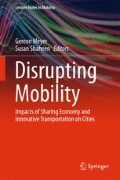Abstract
As computers have become cheap and mobile—most notably in the form of the smartphone—the data and information that they convey has become increasingly practical and spatial for a critical mass of consumers. In short, through mobile devices and GPS functionality, a substantial connected class can now find information that is relevant to them based on where they are, and when they are there. One of the most practical and common behaviors exhibited is the ability to check digital maps and transport information while mobile, often with real-time data. What influence might this have on travel behavior? This study uses focus groups to gain an exploratory understanding of the qualitative influence that information communication technology (ICT) exerts on travel mode choice.
Access this chapter
Tax calculation will be finalised at checkout
Purchases are for personal use only
Notes
- 1.
Only static planned schedule information is available. The line does not feature real-time reporting.
- 2.
Since the study took place real-time bus arrival information has become available for all bus lines in the city.
- 3.
The BeeLine system did not provide GTFS data at this time, which as a standardized data feed allows third party applications to present schedule information. This limits the applications and information sources that the rider can utilize.
- 4.
The train journey was recorded to be 4 min longer than the car journey.
References
Iftekhar, S., Tapsuwan, S.: Review of transportation choice research in Australia: Implications for sustainable urban transport design. Nat Resour Forum 34(4), 255–265 (2010)
SocialData, Evaluation of Australian TravelSmart Projects in the ACT, South Australia, Queensland,Victoria and Western Australia: 2001–2005, Government Report, Australian Greenhouse Office in the Department of the Environment and Heritage, Canberra, 2005
Harley, J. B.: Deconstructing the map. Cartographica: Int. J. Geogr. Inf. Geovisualization. 26(2), 1–20 (1989)
Jain, J.C.: Bypassing and WAPing: reconfiguring timetables for real time mobility. In: Sheller, M., UrryMobile, J. (eds.) Technologies of the city, pp. 79–101. Routledge, London (2006)
Tang, L., Thakuriah, P.: Ridership effects of real-time bus information system: a case study in the City of Chicago. Transp. Res. Part C Emerg. Technol. 22, 146–161 (2012)
Tang, L., Thakuriah, P.: Will the psychological effects of real-time transit information systems lead to ridership gain? Transp. Res. Rec. 2216, 67–74 (2012)
Brakewood, C., Macfarlane, G.S., Watkins, K.E.: The impact of real-time information on bus ridership in New York City. Transp. Res. Part C Emerg. Technol. 53, 59–75 (2015)
Zhang, F., Shen, Q., Clifton, K.: Examination of traveler responses to real-time information about bus arrivals using panel data. Transp. Res. Rec. J. Transp. Res. Board 2082, 107–115 (2008)
Watkins, K.E., Ferris, B., Borning, A., Rutherford, G.S., Layton, D.: Where is my bus? Impact of mobile real-time information on the perceived and actual wait time of transit riders. Transp. Res. Part A Policy Pract. 45(8), 839–848 (2011)
Line, T., Jain, J., Lyons, G.: The role of ICTs in everyday mobile lives. J. Transp. Geogr. 19(6), 1490–1499 (2011)
Aguilera, A., Guillot, C., Rallet, A.: Mobile ICTs and physical mobility: review and research agenda. Transp. Res. Part A 46(4), 664–672 (2012)
Tang, L., Thakuriah, P.: Ridership effects of real-time bus information system: a case study in the City of Chicago. Transp. Res. Part C Emerg. Technol. 22, 146–161 (2012)
Bottsman, R., Woo, R.: What’s mine is yours: the rise of collaboartive consumption. Harper Collins Publishers, New York (2010)
Benkler, Y.: Sharing nicely: on shareable goods and the emergence of sharing as a modality of economic production. Yale Law J. 114(2), 273–358 (2004)
Author information
Authors and Affiliations
Corresponding author
Editor information
Editors and Affiliations
Rights and permissions
Copyright information
© 2017 Springer International Publishing AG
About this chapter
Cite this chapter
Davidson, A.L. (2017). Getting Around with Maps and Apps: How ICT Sways Mode Choice. In: Meyer, G., Shaheen, S. (eds) Disrupting Mobility. Lecture Notes in Mobility. Springer, Cham. https://doi.org/10.1007/978-3-319-51602-8_11
Download citation
DOI: https://doi.org/10.1007/978-3-319-51602-8_11
Published:
Publisher Name: Springer, Cham
Print ISBN: 978-3-319-51601-1
Online ISBN: 978-3-319-51602-8
eBook Packages: EngineeringEngineering (R0)

